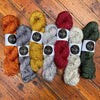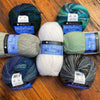Copyright is something most of us have a passing familiarity with. You probably know that you're supposed to buy your own copy of knitting patterns instead of sharing with friends. It's also why we don't allow returns on patterns, magazines, and books. But you may have also noticed that every knitting pattern uses the same stitches, and many patterns contain similar elements. Why is the former no good while the latter is ok?
We're digging a little deeper into copyright with our favorite teacher, Parna Mehrbani, who also happens to be a lawyer specializing in intellectual property matters.
What ISN'T copyright?
- Trademarks - These are symbols, words, images used to identify goods and services. For example, Twisted ® is a registered trademark that our business owns.
- Patents - These apply to inventions. New ideas and technology like a pharmaceutical or the design for machinery.
- Trade Secrets - These are confidential information that a business uses.
What IS copyright?
Copyright, in contrast to the above, is an original work of authorship set in any tangible medium of expression. So, yes, this extends to patterns for knitting, crochet, needlework (and more). And the best part? You get a copyright just by creating something! There is no need to register it or have a "©" on the work.
But... the fine print is that no one can own the overall shape of a utilitarian object like a sock or sweater. Or a core concept like the knit stitch. Copyright applies to an original, novel version of an object or design.
What does copyright protect?
The owner of copyrighted work, for example a knitting pattern, has exclusive rights. This includes such things as being able to reproduce it, prepare “derivative” versions, and distribute copies. There is also a “display” right, which in this contexts could be interpreted to extend to displaying the object.
What happens when you buy a pattern? The owner still has the exclusive rights as author, but you as a purchaser also have separate, limited ownership right in that copy - either printed or digital. Just like you can buy a CD (well, back in the day) or download a copy of an .mp3 file, you own the album either way, egardless of the format in which you purchased it.
How do people infringe on copyright?
- Printing patterns from the Internet (or anywhere) and distributing them to others.
- Copying and distributing single patterns from books or magazines.
- Asking your LYS to photocopy patterns for you (they will politely decline).
- Not respecting social media sites’ rules/terms.
How do I avoid infringing?
Knitting patterns often include some copyright information about who and how they can be used or shared. If it isn't clear, ask the designer. There are lots of times the designer may be perfectly fine with someone using their design in some way or another, but you should make it a habit to ask first before:
- Distributing a photocopy (or a copy of a PDF)...
- Selling items made from the pattern...
- Using the pattern in a class or for a knit/crochet-a-long...
The bottom line
“Publicly available” (e.g., for sale on Ravelry) doesn’t mean a pattern is in the “public domain” (no copyright). And “free” (no cost) does not mean “you are free to distribute it”. Designers deserve respect and recognition and compensation for their work. From a bigger picture perspective, it benefits all of us when designers can succeed financially, because that means more patterns for everyone to enjoy!






